AMD Opteron X3421 Benchmarks
For this exercise, we are using our legacy Linux-Bench scripts which help us see cross-platform “least common denominator” results we have been using for years as well as several results from our updated Linux-Bench2 scripts. At this point, our benchmarking sessions take days to run and we are generating well over a thousand data points. We are also running workloads for software companies that want to see how their software works on the latest hardware. As a result, this is a small sample of the data we are collecting and can share publicly. Our position is always that we are happy to provide some free data but we also have services to let companies run their own workloads in our lab, such as with our DemoEval service. What we do provide is an extremely controlled environment where we know every step is exactly the same and each run is done in a real-world data center, not a test bench.
We are going to show off a few results, and highlight a number of interesting data points in this article.
Python Linux 4.4.2 Kernel Compile Benchmark
This is one of the most requested benchmarks for STH over the past few years. The task was simple, we have a standard configuration file, the Linux 4.4.2 kernel from kernel.org, and make the standard auto-generated configuration utilizing every thread in the system. We are expressing results in terms of compiles per hour to make the results easier to read:
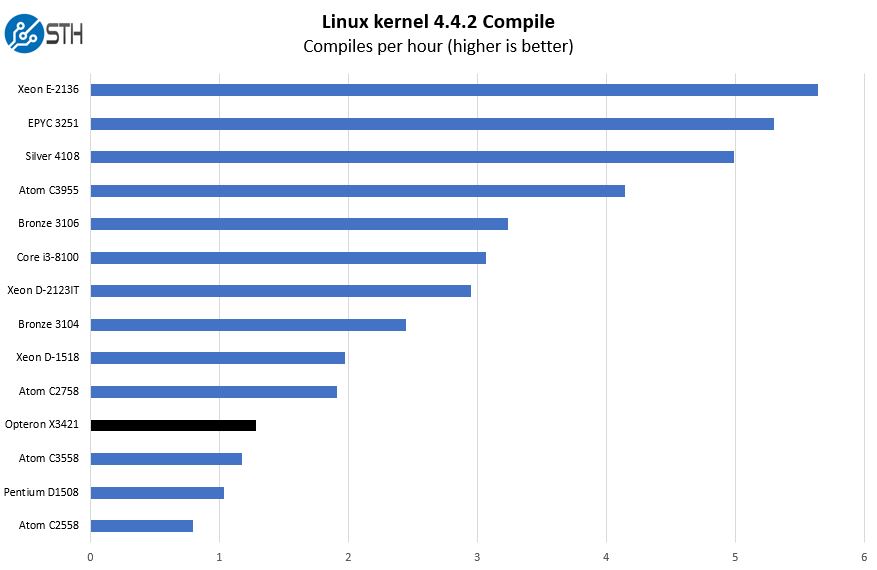
Here we can see performance above a quad-core Intel Atom C3558. The Intel Atom C3558 is part of the Intel “Denverton” series of CPUs and does not include an integrated GPU.
c-ray 1.1 Performance
We have been using c-ray for our performance testing for years now. It is a ray tracing benchmark that is extremely popular to show differences in processors under multi-threaded workloads. We are going to use our 4K results which work well at this end of the performance spectrum.
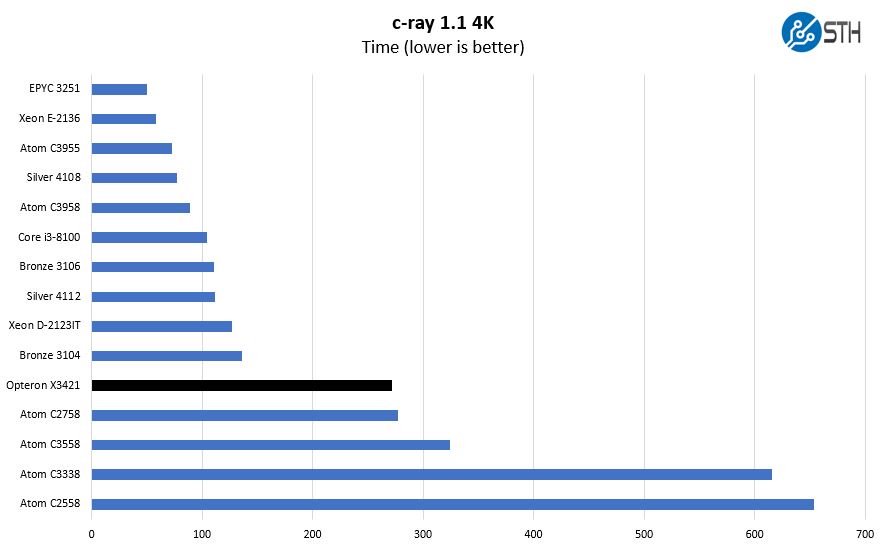
Built on the AMD Excavator core, the AMD Opteron X3421 is not the c-ray (or Cinebench) monster one would expect from the Zen cores. Instead, it is an older 28nm core which performs well, but it is still a long way to the higher-end cores.
Since we are still within the Intel Atom C2758 product lifecycle, we wanted to note four X3421 cores beat eight C2000 cores here.
7-zip Compression Performance
7-zip is a widely used compression/ decompression program that works cross-platform. We started using the program during our early days with Windows testing. It is now part of Linux-Bench.
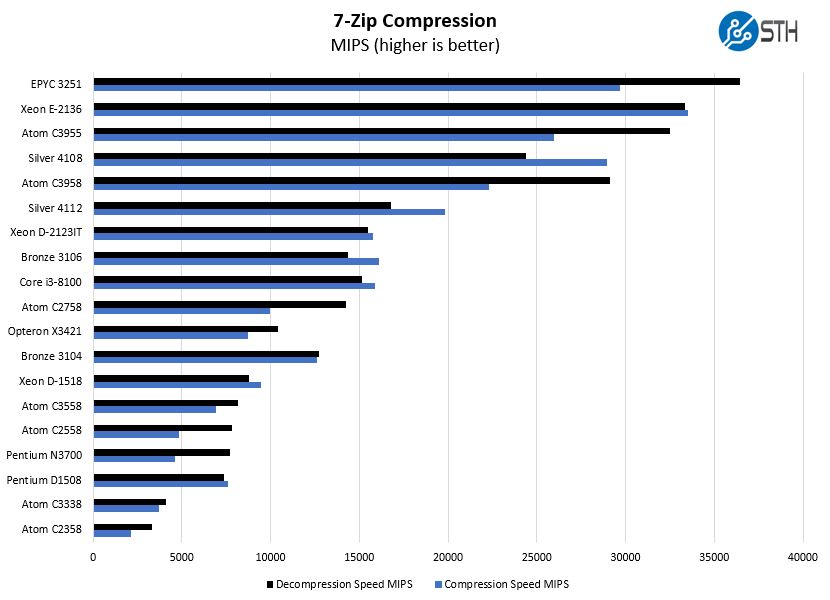
This is one of the more interesting results we had. Here, the AMD Opteron X3421 performed slightly better than the Intel Xeon D-1518 which is an impressive result.
NAMD Performance
NAMD is a molecular modeling benchmark developed by the Theoretical and Computational Biophysics Group in the Beckman Institute for Advanced Science and Technology at the University of Illinois at Urbana-Champaign. More information on the benchmark can be found here. We are going to augment this with GROMACS in the next-generation Linux-Bench in the near future. With GROMACS we have been working hard to support Intel’s Skylake AVX-512 and AVX2 supporting AMD Zen architecture. Here are the comparison results for the legacy data set:
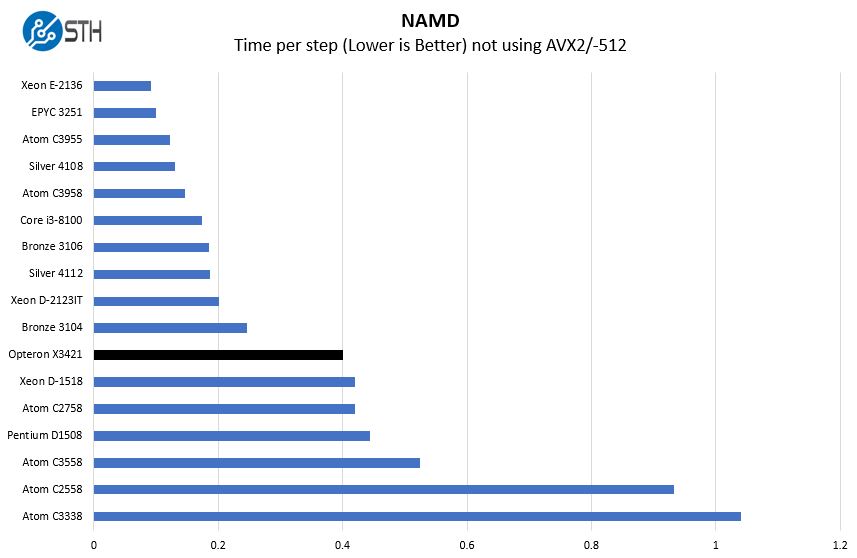
Again, we see the AMD Opteron X3421 slightly passing the lower core count Broadwell-DE chips. It is worth noting that the AMD Opteron X3421 has a configurable TDP up to 35W. The chips that are performing much better here also have a higher TDP. The Intel Core i3-8100 has an iGPU, higher clock speeds, but also a 65W TDP.
Sysbench CPU test
Sysbench is another one of those widely used Linux benchmarks. We specifically are using the CPU test, not the OLTP test that we use for some storage testing.
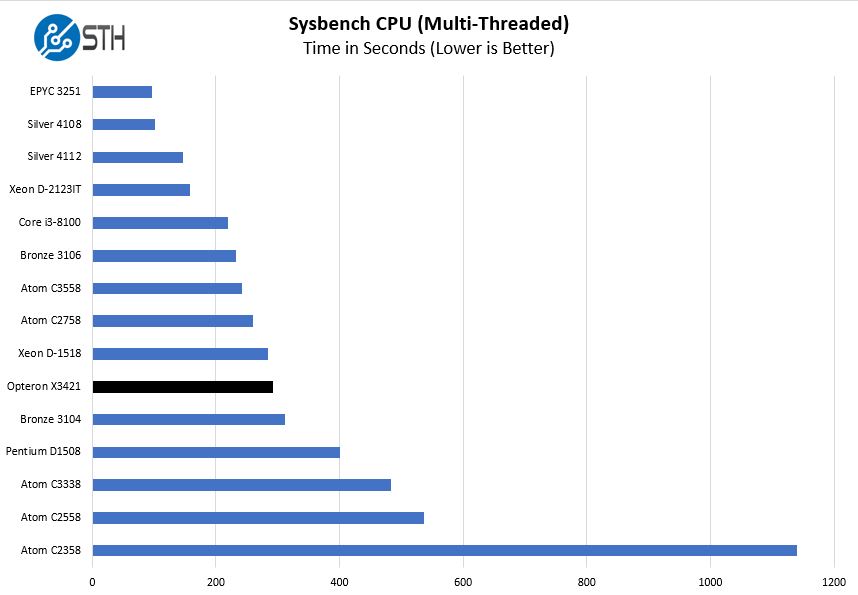
Here the quad-core CPU with slightly higher clock speeds is able to out-pace the Intel Xeon Bronze 3104. That is a fantastic result as the Xeon Bronze 3104 chip itself is almost the price of a discounted HPE ProLiant Microserver Gen10 with AMD Opteron X3421.
OpenSSL Performance
OpenSSL is widely used to secure communications between servers. This is an important protocol in many server stacks. We first look at our sign tests:
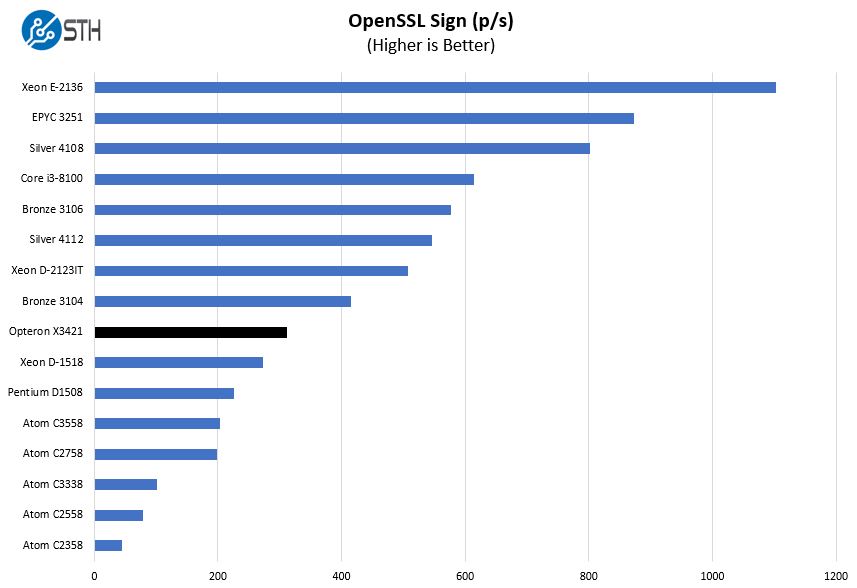
Here are the verify results:
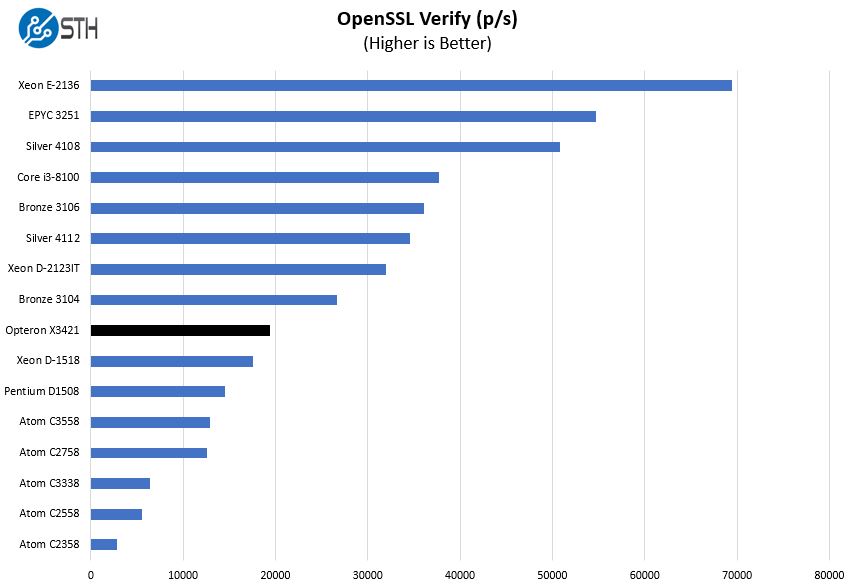
Again we can see the AMD Opteron X3421 place just a bit higher than the Intel Atom C3000 series with competitive core counts and above the Intel Xeon D-1500 series here.
UnixBench Dhrystone 2 and Whetstone Benchmarks
Some of the longest-running tests at STH are the venerable UnixBench 5.1.3 Dhrystone 2 and Whetstone results. They are certainly aging, however, we constantly get requests for them, and many angry notes when we leave them out. UnixBench is widely used so we are including it in this data set. Here are the Dhrystone 2 results:
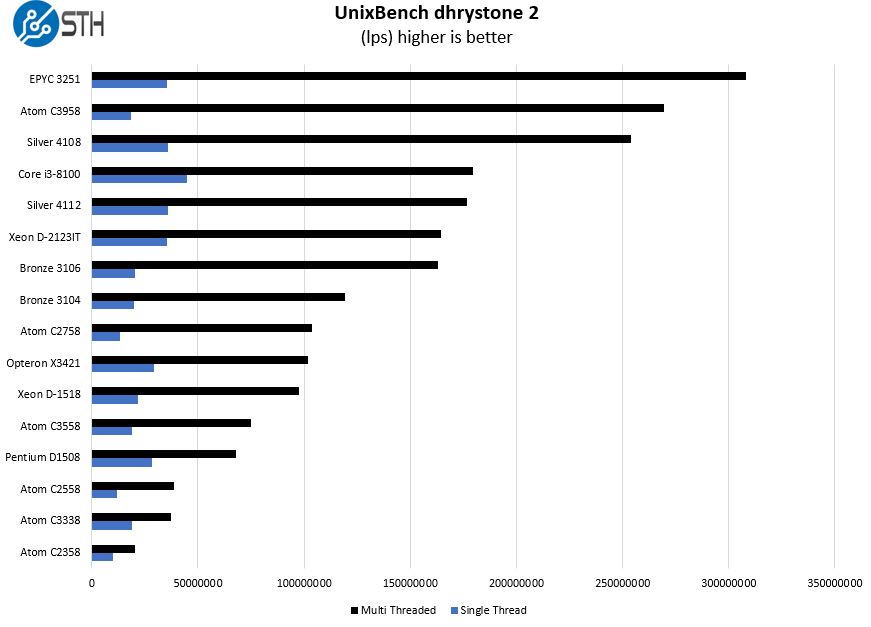
Here are the whetstone results:
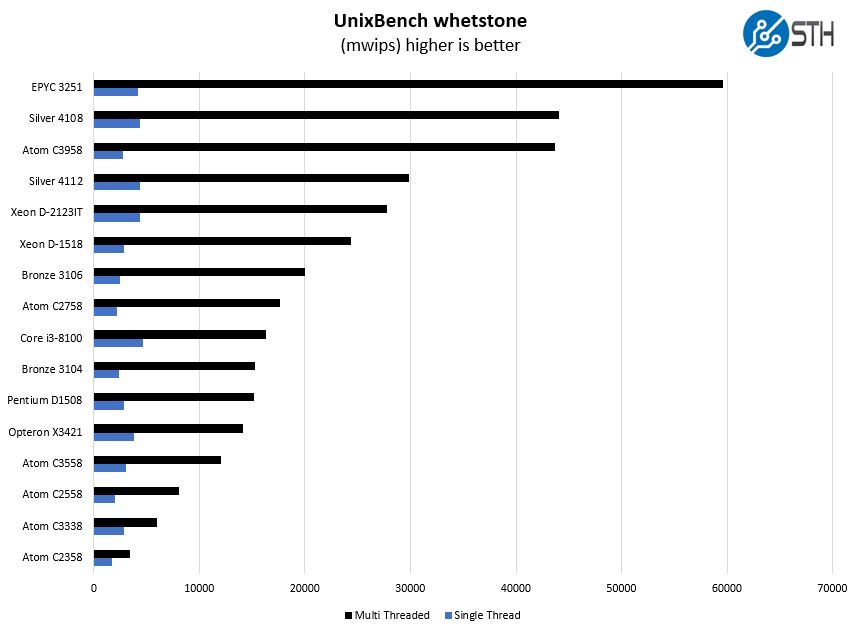
If you are looking for single-threaded performance, chips like the Intel Core i3-8100 are going to have more performance. For the lower-power embedded space, one can see higher per-core performance which aligns with how the AMD Opteron X3421 is seeing more performance on a core-for-core basis than some of its low power Intel competition.
GROMACS STH Small AVX2/ AVX-512 Enabled
We have a small GROMACS molecule simulation we previewed in the first AMD EPYC 7601 Linux benchmarks piece. In Linux-Bench2 we are using a “small” test for single and dual socket capable machines. Our medium test is more appropriate for higher-end dual and quad socket machines. Our GROMACS test will use the AVX-512 and AVX2 extensions if available.
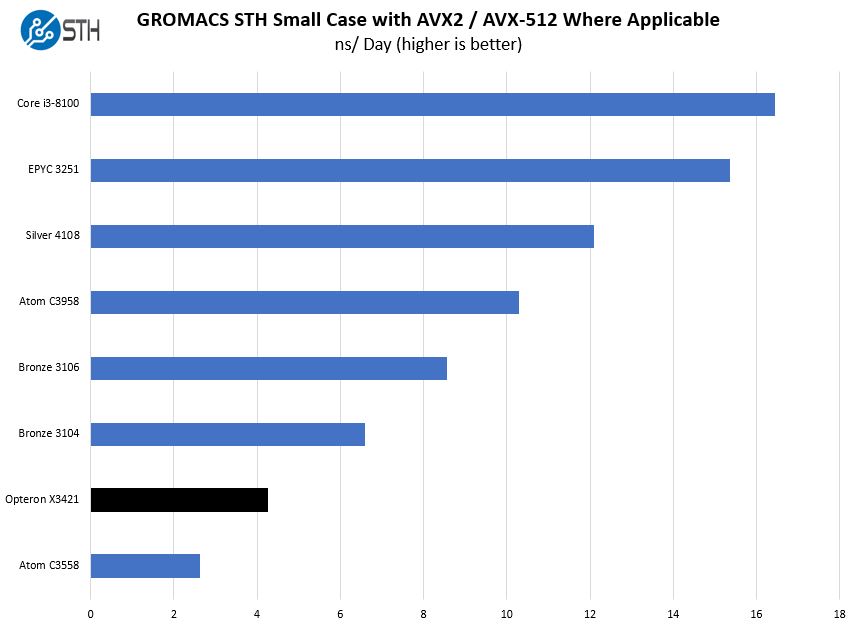
We did not test many of our older-generation CPUs with GROMACS, and frankly, this type of workload is not something you would expect to see run on a microserver. Take these results as more directional.
Chess Benchmarking
Chess is an interesting use case since it has almost unlimited complexity. Over the years, we have received a number of requests to bring back chess benchmarking. We have been profiling systems and are ready to start sharing results:
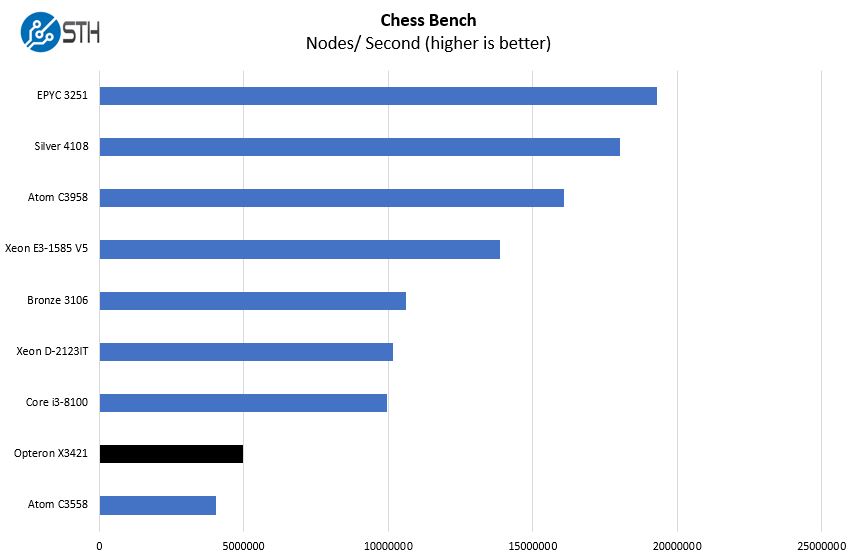
On the chess benchmark side, we again see the chip perform better than the Intel Atom C3000 series at the same core count, but not to where we would expect an Intel Core i3, Xeon E3, or Xeon E-2100 series.
Next, we are going to look at the AMD Opteron X3421 market positioning relative to other AMD and Intel offerings before concluding with our final thoughts.




I mean, if you need more computing power you will want more RAM and 2 slots isn’t enough.
We’ve got 7 microservers with these for a K8s cluster. You’re right they need more PCIe and 10gb networking. I’d never get the dual core.
The Gen8 was a better server. The suggestion of the EPYC 3000 in a Microserver with 10G and more PCIe will keep me from sleeping tonight. Thanks a lot STH!
This would be a nice CPU for use as a pfsense router. Would be nice if it has the 10Gbe right away though.
Was hoping to get data about noise and wattage:(
I like this CPU and there’s no alternative from the competitor. You can get very decent performance, with graphics and nice virtualization at very low wattage. Only glitch on the gen10 microserver is the fan plug. The highest current Opteron is the choice for 10gbit solution. Forget gen8.